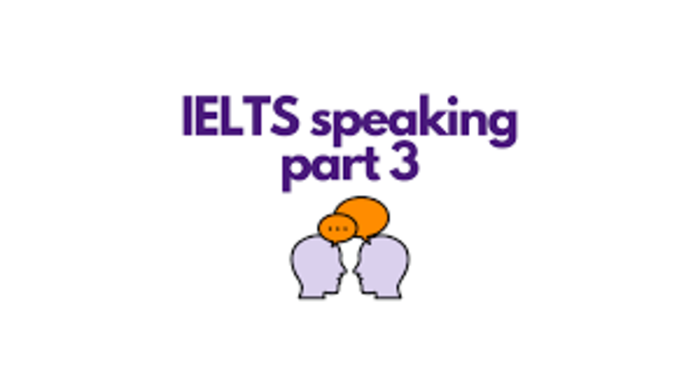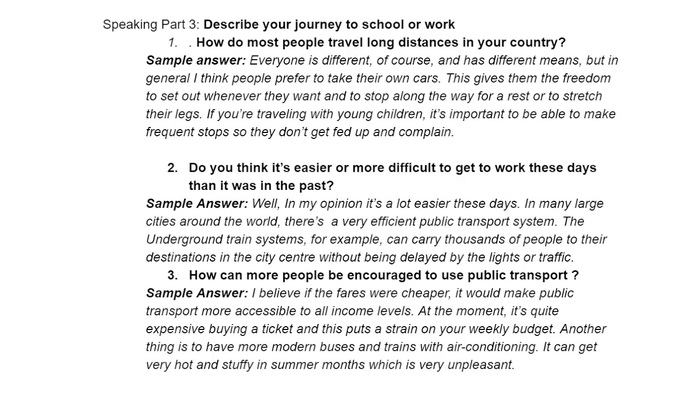Các loại câu hỏi thường gặp trong IELTS Speaking Part 3 bao gồm câu hỏi mở rộng, so sánh, nguyên nhân – kết quả, dự đoán và giải pháp. Để trình bày quan điểm một cách rõ ràng và thuyết phục, thí sinh cần có chiến lược cụ thể và phương pháp trả lời hợp lý. Bài viết này sẽ cung cấp chi tiết cách trình bày quan điểm IELTS Speaking Part 3.
Tổng quan về IELTS Speaking Part 3
Phần thi IELTS Speaking Part 3 thường kéo dài từ 4 đến 5 phút và bao gồm một loạt các câu hỏi liên quan đến chủ đề đã được thảo luận ở phần 2. Giám khảo sẽ hỏi các câu hỏi mở rộng, mang tính phân tích và yêu cầu thí sinh thể hiện quan điểm, lập luận và khả năng phân tích sâu hơn.
Phần này nhằm đánh giá:
- Khả năng diễn đạt quan điểm và ý kiến cá nhân.
- Khả năng phân tích, so sánh và suy luận logic.
- Khả năng mở rộng và phát triển ý tưởng một cách mạch lạc.
- Khả năng sử dụng ngôn ngữ phức tạp và từ vựng đa dạng.
Các loại câu hỏi thường gặp:
- Câu hỏi mở rộng: “How do you think technology has changed the way we communicate?”
- Câu hỏi so sánh: “Do you think that children nowadays have more freedom than in the past?”
- Câu hỏi nguyên nhân – kết quả: “What are the effects of global warming on the environment?”
- Câu hỏi dự đoán: “What do you think will be the impact of electric cars on the environment in the next 20 years?”
- Câu hỏi giải pháp: “What measures can be taken to reduce air pollution in big cities?”

Tổng quan về IELTS Speaking Part 3
Trình bày quan điểm IELTS Speaking Part 3
Trong phần thi IELTS Speaking Part 3, việc trình bày quan điểm một cách rõ ràng, mạch lạc và thuyết phục là rất quan trọng. Dưới đây là một số chiến lược và cấu trúc giúp bạn trình bày quan điểm IELTS Speaking Part 3 hiệu quả:
Đưa ra quan điểm rõ ràng:
- Mở đầu: Bắt đầu câu trả lời của bạn bằng cách đưa ra quan điểm chính. Điều này giúp giám khảo hiểu ngay lập tức bạn đang nói về điều gì.
- Ví dụ: “In my opinion, …”, “I believe that …”, “From my perspective, …”
Giải thích lý do:
- Phát triển ý: Sau khi đưa ra quan điểm, giải thích lý do tại sao bạn lại có quan điểm đó. Sử dụng các lập luận logic và lý do hợp lý để hỗ trợ quan điểm của mình.
- Ví dụ: “This is because …”, “The reason for this is …”, “One major reason is …”
Đưa ra ví dụ cụ thể:
- Ví dụ minh họa: Sử dụng các ví dụ cụ thể để minh họa và làm rõ quan điểm của mình. Ví dụ có thể là từ kinh nghiệm cá nhân, các sự kiện thực tế, hoặc các nghiên cứu khoa học.
- Ví dụ: “For example, …”, “A good example of this is …”, “To illustrate this point, …”
Đưa ra thêm thông tin chi tiết:
- Chi tiết bổ sung: Cung cấp thêm thông tin chi tiết hoặc mở rộng ý tưởng để làm cho câu trả lời của bạn phong phú hơn và sâu sắc hơn.
- Ví dụ: “Furthermore, …”, “Additionally, …”, “Moreover, …”
Kết luận:
- Tóm tắt: Kết luận câu trả lời của bạn bằng cách tóm tắt quan điểm chính hoặc nhấn mạnh lại ý kiến của bạn.
- Ví dụ: “In conclusion, …”, “To sum up, …”, “Overall, …”

Trình bày quan điểm IELTS Speaking Part 3
Ví dụ cụ thể về cách trả lời:
- Câu hỏi: “Do you think that advertising influences people’s food choices?”
- Trả lời:
- “In my opinion, advertising has a significant influence on people’s food choices. This is because advertisements are designed to be persuasive and often highlight the appealing aspects of food products. For example, many fast food commercials emphasize the convenience and deliciousness of their meals, which can tempt people to choose fast food over healthier options. Furthermore, advertising often targets children, who are easily influenced and can pressure their parents into buying advertised products. Overall, the power of advertising cannot be underestimated when it comes to shaping our food preferences.”
- Trả lời:
Một số cụm từ hữu ích:
- Để trình bày quan điểm:
- “I think/believe that…”
- “In my opinion,…”
- “From my perspective,…”
- “As far as I’m concerned,…”
- Để giải thích lý do:
- “This is because…”
- “The main reason is…”
- “One reason for this is…”
- “This can be attributed to…”
- Để đưa ra ví dụ:
- “For instance,…”
- “To give you an example,…”
- “A case in point is…”
- “Such as…”
- Để mở rộng ý tưởng:
- “Moreover,…”
- “In addition,…”
- “Furthermore,…”
- “What’s more,…”
- Để kết luận:
- “To sum up,…”
- “In conclusion,…”
- “All in all,…”
- “Overall,…”
Chiến lược trả lời IELTS Speaking Part 3
Bài mẫu trả lời IELTS Speaking Part 3
Câu hỏi 1: How has technology changed the way we learn?
Trả lời:
In my opinion, technology has dramatically transformed the way we learn, making education more accessible, interactive, and personalized. This is primarily because of the proliferation of online learning platforms and educational apps. For example, platforms like Coursera and Khan Academy offer a wide range of courses from prestigious institutions, allowing students from around the world to access high-quality education at their own pace. Moreover, interactive tools such as virtual reality can create immersive learning experiences, making complex subjects like anatomy or history more engaging. Additionally, technology enables personalized learning through adaptive learning systems that cater to individual student’s needs, helping them to progress at their own pace. Overall, the integration of technology in education has made learning more flexible and tailored to individual preferences.
Câu hỏi 2: Do you think children today are more dependent on technology than in the past?
Trả lời:
Absolutely, I believe that children today are much more dependent on technology compared to previous generations. This dependency can be attributed to several factors. Firstly, the ubiquitous presence of smartphones, tablets, and computers has made technology an integral part of children’s daily lives. For instance, many children use devices for both educational and entertainment purposes, such as online classes, games, and social media. Secondly, the shift towards digital learning, especially during the COVID-19 pandemic, has further increased children’s reliance on technology for their education. Additionally, parents often encourage the use of educational apps and digital resources to supplement traditional learning methods. While technology can provide numerous benefits, it’s crucial for parents and educators to ensure a balanced use to avoid over-dependence and potential negative effects on children’s social and physical development.
Câu hỏi 3: What are the disadvantages of relying too much on technology in education?
Trả lời:
Relying too heavily on technology in education can have several disadvantages. One significant issue is the potential for decreased face-to-face interaction. As students spend more time on digital devices, they might miss out on important social skills that are typically developed through in-person interactions with peers and teachers. For example, collaborative projects and classroom discussions are essential for developing teamwork and communication skills, which may not be as effectively fostered in a virtual environment. Another concern is the risk of distraction. With access to the internet, students can easily be tempted to browse social media or play games instead of focusing on their studies. Furthermore, excessive screen time can lead to health problems such as eye strain, poor posture, and disrupted sleep patterns. Lastly, there is the issue of digital divide, where students from low-income families may not have access to necessary technological resources, exacerbating educational inequalities. Therefore, while technology offers many advantages, it is important to use it judiciously and ensure that traditional learning methods are not entirely replaced.
Xét tuyển vào VinUni yêu cầu IELTS bao nhiêu?
Để được nhận vào Trường Đại học VinUni, ứng viên phải có điểm IELTS tối thiểu là 6.5 (không có kỹ năng nào dưới 6.0). Điều này đảm bảo rằng sinh viên đủ điều kiện để đăng ký các khóa học được giảng dạy hoàn toàn bằng tiếng Anh. Trong trường hợp ứng viên không đạt được điểm tối thiểu, bạn vẫn có thể tham gia chương trình Pathway English của VinUni.
Mục tiêu của Pathway English là hỗ trợ sinh viên trở nên thông thạo ngôn ngữ hơn và chuẩn bị tốt hơn cho việc học tập tại VinUni. Toàn bộ sự phát triển về khả năng đọc, nghe, nói và viết tiếng Anh học thuật là mục tiêu chính của khóa học này. Hơn nữa, sinh viên sẽ được hướng dẫn toàn diện về ngữ pháp, phát âm và từ vựng chuyên ngành. Vào cuối khóa học, sinh viên sẽ tự tin hơn và có các kỹ năng tiếng Anh cần thiết để đăng ký vào các chương trình chuyên ngành của VinUni.
Hy vọng bài viết trên về trình bày quan điểm IELTS Speaking Part 3 sẽ hữu ích cho bạn đọc trong quá trình ôn luyện!
















